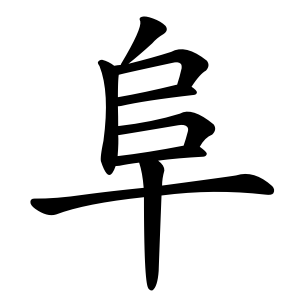阜
- hill;
Usage in Korean
When the 阝 radical is placed on the left side, it is called the left 阜 radical (⻖, 좌부변, 左阜 边) and originates from the ancient form of 阜 (hill, mound).
When placed on the right side, it is called the right 邑 radical (⻏, 우부방, 右阜 傍) and originates from the ancient form of 邑 (town, village).
The left 阝 (⻖) is mainly used in characters related to geography, such as hills, mounds, or ridges.
The right 阝 (⻏) is mainly used in characters related to place names or settlements (towns, villages).
Notably, the character 阜 itself is not used as a radical by itself in any Chinese character; only its left or right abbreviated forms appear as radicals.
Alternative forms
Derived characters
There is also a variant form (informal character) 峊.
Characters with 阜
8 strokes
10 strokes
11 strokes
12 strokes
13 strokes
14 strokes
16 strokes
阜
언덕
부
eondeok
bu
Kangxi radical:170
Strokes:8
Unicode:U+961C
Cangjie input:
- 竹口十 (HRJ)
Composition:
- ⿱ 𠂤 十
